Brazil - Land of Diversity: Traces of German Culture

The Legacy of German Immigrants in the State of Santa Catarina
When planning your trip to Brazil, you should also make a stop in the so-called Vale Europeu (European Valley) in the north of the state of Santa Catarina. Many people do not know that there are many traces of European and German immigrants in the south of the country.
Today we would like to take you on a historical excursion and introduce you to the region.
Historical excursion
There is more Germany in Brazil than some people think. About ten percent of Brazilians are said to have German ancestors. In the 19th and 20th centuries, there were downright waves of immigration to Brazil. In times of industrialization, many small craftsmen and workers in industry and agriculture lost their jobs and had to look for new opportunities. These factors and of course personal motives led to emigration during this period. In Brazil, the immigrants were usually given a piece of land as a gift to promote colonization.
Traces of immigration today
One of the most famous Brazilians with German roots is the model Gisele Bündchen.
But many cities, especially in the state of Santa Catarina, today show many German characteristics not only in their names but also in their cultural history. One of these cities is Blumenau, which is located north of Florianopolis. It was founded in 1850 by the pharmacist of the same name from Hasselfelde in Saxony-Anhalt. Today there is an imposing mausoleum in the center of the town with its bones.
There are still some Blumenau residents who speak German as a colloquial language - many speak it in the dialect of the homeland from which their ancestors came, for example from Pomerania. But most of them speak above all the actual national language, Portuguese. In the first hundred years after its foundation, however, German was indeed the predominant language - which was certainly also because the Germans had by then created a good infrastructure for their culture.
Of course, German beer is also available in Blumenau. This is called, for example, "Eisenbahn" and is brewed according to the German Purity Law. The brewery exists since 2002 and the different kinds of barley juice are sold all over Brazil. There is also a small museum where you can learn about the history of beer in the state.
While we are on the subject of beer, every year there is an Oktoberfest in Blumenau which is the second-largest in the world after Munich - and the second largest festival in Brazil after the Carnival of Rio.
Since 1984 it has been organized annually in Blumenau in the Vila Germanica (German Village). Today it attracts an average of 600,000 people every year. Nowhere else can one better observe how German and Brazilian culture meet.
Near Blumenau is the small town of Pomerode. It is called the most German city in Brazil because about 92 percent of its inhabitants have German roots. Also here you can find former houses of immigrants, which today house museums, as well as many buildings in the style of the brick houses of Northern Germany. Especially on the Rota do Enxaimel, a tourist route with many beautiful houses, one has the feeling of being in a German housing estate from the last century.
On your next vacation in Brazil, you should include a visit to Blumenau. For example at Praia do Rosa you will see the natural treasures of Santa Catarina.
Source: expedia.de

